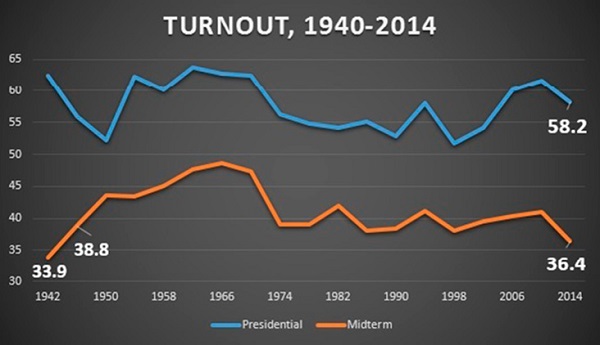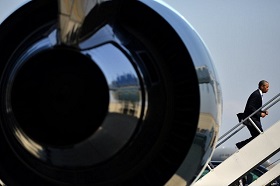The recent speech by US President Barack Obama in Cleveland, Ohio, in which he supported the idea of introducing a system of mandatory voting in America, at least at federal level, made quite a splash in the US media. The thinking behind this proposal is extremely simple – all voters registered in the states are compulsorily required to turn out and vote on polling day in presidential and congressional elections and to have the opportunity to vote for candidates for the presidency or the US Congress on a mandatory basis.
The recent speech by US President Barack Obama in Cleveland, Ohio, in which he supported the idea of introducing a system of mandatory voting in America, at least at federal level, made quite a splash in the US media. The thinking behind this proposal is extremely simple – all voters registered in the states are compulsorily required to turn out and vote on polling day in presidential and congressional elections and to have the opportunity to vote for candidates for the presidency or the US Congress on a mandatory basis. It should be pointed out at the outset that as Obama himself admitted, there is little chance of this proposal being put into effect in the near future, since it would require a constitutional amendment. The process of making such an amendment can take many years, even decades. However, Barack Obama added that he had already instructed the Department of Justice to take steps to expand citizens’ involvement and to remove all restrictions in elections at the local and state level.
For all the apparent simplicity and straightforwardness of this initiative to improve the institutions of American democracy, however, if it were put into effect it would be of truly revolutionary significance for American politics. Barack Obama himself quite frankly outlined the hopes and calculations which the current leadership of the Democratic Party links to the introduction of a system of mandatory voting in America. These are the precise words the US president used: “In Australia, and some other countries, there’s mandatory voting. It would be transformative if everybody voted. That would counteract money more than anything. If everybody voted, then it would completely change the political map in this country, because the people who tend not to vote are young; they're lower income; they're skewed more heavily towards immigrant groups and minority groups; and they're often the folks who are scratching and climbing to get into the middle class. And they're working hard, and there’s a reason why some folks try to keep them away from the polls. We should want to get them into the polls.”
It’s telling that having begun his speech in Cleveland with a panegyric on American democracy, Obama subtly switched to referring to the democratic experience of other countries. Apart from Australia, however, the system of mandatory voting exists in ten other countries, including Brazil, Argentina, Uruguay and Singapore, not to mention North Korea. The outcome of the US congressional elections in 2014, in which the Democrats suffered a crushing defeat, was undoubtedly what lay behind Obama’s proposal to improve the institutions of American democracy. American analysts, meanwhile, were not slow to note that one of the main factors in the Democrats’ defeat was the record low turnout – the lowest since 1942. In November 2014 just 36.4% of registered voters turned out to vote, while 1942 when the War was in full swing the figure was 33.9%. The steady decline in the active involvement of American voters in congressional elections over the last 40 years is clearly shown in figure.
Turnout of American voters in presidential and congressional elections, 1942–2014, %

The voter turnout in approximately 20 American states in the 2014 elections was lower than the national level, including in such major states as Ohio (36.2%), Pennsylvania (36.1%), California (31.8%), New Jersey (30.4%), New York (28.8%), Texas (28.5%) and Indiana (28%). Apart from this, the 2014 congressional elections showed that it was whites and the more wealthy, educated and older people who were more likely to vote.
Comparative profile of groups of American voters in 2014 congressional elections 2014, %
| | Voter turnout 2014 | Proportion of US population |
| Ethnic group: | |
| − white | 75 | 62,6 |
| − −hispanic | 8 | 17,1 |
| Annual income: | |
| − more than 50,000 dollars | 64 | 52 |
Education: | | |
| − college graduate | 51 | 28,5 |
| − not completing high school | 2 | 14,3 |
| Age: | |
| − over 65 | 22 | 14,1 |
| − under 30 | 13 | 16.8 |
Source
Barack Obama’s hope that the USA’s Democratic Party will gain most from the introduction of a mandatory voting system at the federal level is confirmed by Australia’s experience: the introduction of a mandatory voting system in this country in 1924 increased voter turnout from 65% to 95%, as a result of which the centre-left Labor Party began to receive approximately 7–10% more than its rivals, the right-wing Conservatives. Naturally, representatives of the right-wing conservative forces in the USA promptly rejected Obama’s initiative. Fox News analyst Andrew Napolitano, for example, called this part of Barack Obama’s Cleveland speech a “totalitarian impulse” by the president and a sign of the USA’s slide towards “fascist” states. This is possibly what caused White House Press Secretary Josh Earnest to state that the president “had not made any specific or legislative initiative”. It would seem that nowadays the “benchmark” democracy needs to be amended.
1. Fowler A., ‘Electoral and Policy Consequences of Voter Turnout: Evidence from Compulsory Voting in Australia’, Quarterly Journal of Political Science, 2013, No. 8, p. 161






